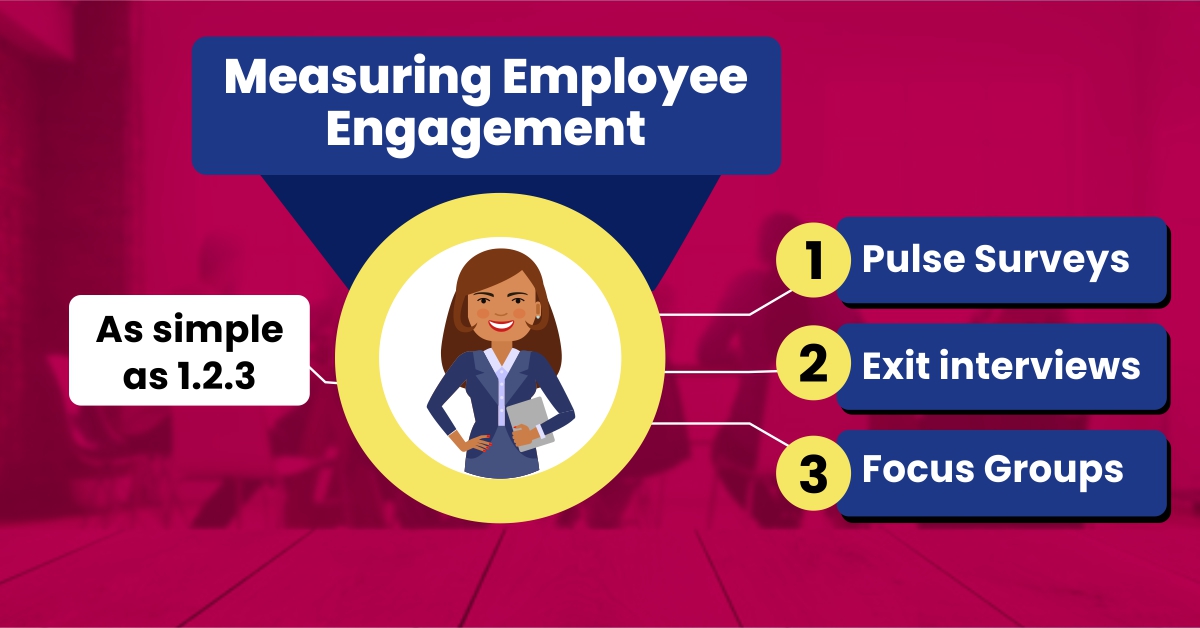“If you cannot measure it, you cannot improve it”- Lord Kelvin In my LinkedIn article, I had explained what employee engagement is and is not.
As you can only work towards improving engagement once you know where you currently stand, I’ll talk about how you can measure employee engagement in this blog.
While the current business landscape is flooded with a host of leadership challenges, improving employee engagement is an effective way to eliminate or at least minimize their impact to a major extent.
Why Is It So Difficult to Measure Employee Engagement?
Engaged employees have a strong mental and emotional connection with their work, team members, and organization. In other words, it is a complex amalgamation of human emotions.
And how do you measure emotions?
It is not something as quantitative as their performance or productivity that you can measure every year based on a set of established guidelines. Moreover, engagement could mean different things for different businesses.
As a result, there is no single method that every company could use for measuring employee engagement. Generally, I’ve seen businesses using a combination of a few different techniques to get the best results.
When used correctly, these methods can provide an excellent overview of the current state of engagement across an organization. Here is a list of 3 such ways-
1. Use Pulse Surveys
Frequent, short surveys are one of the most effective ways to gauge your employees’ mood and happiness levels. For instance, you can consider sending weekly surveys with 1-2 questions to get an instant snapshot of what your employees are feeling.
On a monthly or quarterly basis, you can also send out detailed surveys which explore their happiness and satisfaction in greater depth.
The questions in these pulse surveys can revolve around these key metrics-
● Mission Alignment– Questions related to how well the organization’s mission is aligned with the employees’ goals.
● Employee Satisfaction– Questions related to how satisfied the employees are with their work, benefits, salary, etc.
● Future Prospects– The questions will revolve around what the employees think about their future in your organization.
Here are a few tips that can help you improve the effectiveness of your surveys-
● For best results, ensure that all the employees company-wide are included in such surveys.
● Pulse surveys alone cannot be relied upon for measuring or improving engagement. Make use of other tools such as annual employee engagement surveys to get comprehensive feedback.
● Rather than just the quantitative results, focus also on the qualitative feedback that you receive from the employees. Include a mix of scoring as well as open-ended questions in your surveys.
Also, check out this post on “How to Manage Feedback from Different Personality Types” to better respond to your employees’ feedback.
2. Hold Engagement Focus Group
Focus groups are another very popular way for organizations to determine employee engagement. It provides your employees with an opportunity to speak about their company’s perception, their problems, and more.
You can gather your employees in groups of 6-10 and decide 3-5 questions for discussion beforehand. The questions can be about how the employees feel about their work, their contribution to the company’s growth, and whether they have the required tools to do their work effectively.
According to a report by Slack, 85% of the workers want to feel closer to their remote teams. With hybrid working expected to be the future, focus groups can help you encourage your employees to build a deeper connection with their team members and organization even when working remotely.
(My article on “Challenges of Hybrid Work Model” offers some great insights into how businesses can start preparing themselves for the future.)
Here are a few ways to make the most of this initiative-
● Know the exact objective of the focus group and communicate the same to your employees
● Avoid running focus groups during peak business season
● Appoint a neutral moderator for running such groups
3. Exit Interviews Can Give You Some Great Insights
To measure engagement, you’d primarily be focused on the big picture of what is happening across your organization. But at the same time, it is equally important to attend to cases at an individual level. Conducting exit interviews is a smart way to dive deeper into what went wrong for an employee.
While it could be personal reasons why an employee might want to move on, these interviews can often provide great insights into your organization and employees’ perception of the company.
Focus on making the employees as comfortable as possible during such interviews so that they don’t feel guarded or wary of making critical comments.
Here are some questions you can consider for engagement-focused exit interviews-
● Why did you start looking for another opportunity?
● How was your experience working for the company?
● Do you have any suggestions about how we can improve our organization?
● Is the new employer offering something that we don’t?
Measuring Engagement: The First Step Towards Improving Employee Engagement
It is almost impossible to be at the place where you want to be unless you don’t know where you currently are.
While you want to improve employee engagement and experience all the valuable benefits it can deliver, not much can be done unless you first correctly measure where the engagement rate currently stands.
A combination of the methods discussed in this post will provide an exceptional overview of your organization’s current state of engagement. Based on the results, you can then start working on an action plan to boost engagement.
Get in touch with us to find out how we can help you and your organization with employee engagement. We’ve helped organizations across industries and sizes better understand their current engagement levels through our business training and solutions.
Our assistance has enabled them to create better strategies to improve engagement and succeed.


